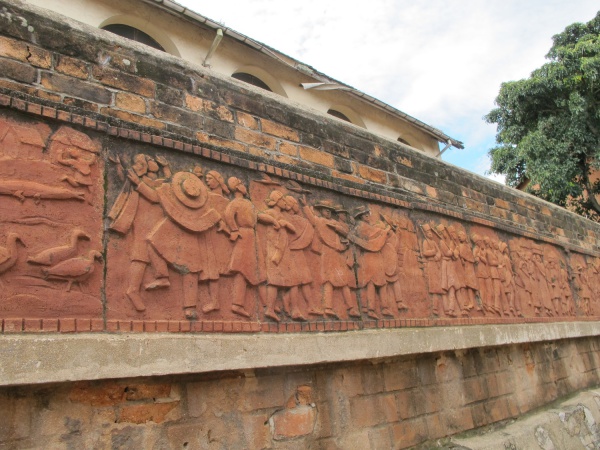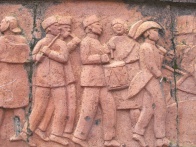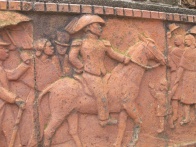Manjakamiadana Rova
The Manjakamiadana Rova (also named Queen's Palace) is the landmark of Antananarivo. Situated at the top of Analamanga Hill, the rova clearly stands out in the skyline of Tana and can be seen from a far distance. From the 17th century to the 19th century the rova served as a residence for the kings and queens of the Merina kingdom.
The original structure of the palace was made of wood, which was changed to stone on order of Queen Ranavalona II in 1869. In 1995 a fire almost completely destroyed the palace, sparing only the stone walls. Since 2005 the palace has been in a state of restoration, which depending on the political situation in the country stops now and then.

| ||

|

|

|
Although the palace is still closed, the location is well worth a visit. Against a small fee, guides will take visitors along a 15-minute trail encircling the palace property whilst explaining the history of the location and various adjoining buildings. Due to its location, the palace offers great panoramic views onto the city and the Twelve Sacred Hills.
Note: Visitors are advised to keep an eye on their belongings as pickpocketing is commonplace in this area.
The Rova of Antananarivo
Text from Passport for Madagascar - 44th edition, January/February 2008
In the Rova of Antananarivo during the period of the Merina royalty, it was taboo to use any other construction materials apart from wood to build the royal house. On her accession to the throne, Queen Ranavalona II ended this tradition and introduced stone specifically for the construction of the Rova church. Because of the very nature of the construction entirely in wood, the Rova was annihilated during a fire on 6 November 1995 in a few hours, watched helplessly by the population. Only the stone walls of the church were capable of resisting this catastrophe, but everything in wood went up in flames (roofs, beams, furnishings, decoration). This was why out of all the buildings in the Rova, it was the first to be entirely restored and this was done fairly quickly when, ten years after the criminal fire, work on the reconstruction of the site began.
The word rova designates the group of royal houses constructed within a wooden wall which no one dared to enter as it was the residence of the sovereign having the earthy status of God the Creator and stemming from this, everything connected with him (his house, his personal belongings, his herds of zebus, the water he drank, etc.) was considered sacred and violation of the prohibitions was punishable by death.
Manjakamiadana
This great royal house in the Rova has become the symbol of royalty in Imerina.
It was Queen Ranavalona I (1828 - 1861) who conceived the idea of having this building, constructed entirely of rare wood, following an architecture differing from other existing houses, and which had only one single room and two openings: one door and one window. The palace of Manjakamiadana (where one rules in peace), as this was the name given by its owner, possesses two floors and attics, a large number of openings and the whole surrounded by a wooden balcony, which for that time was revolutionary.
In common with all wooden constructions, this palace rested on a central pillar, a giant palisander trunk 39 metres high and this piece of wood was, according to some, brought up from the forests of the southeast, and to others from the forest of the east by ten thousand men. The sovereign had the right to call on her subjects to accomplish difficult tasks. These forced labourers were not paid for the work exacted by the sovereign but received rice and zebu meat from the royal herds for the duration of their labour.
As at this time wheeled vehicles did not yet exist, this trunk of wood was carried by foot on the backs of labourers as it could not touch the ground.
The construction of this palace began in 1839 and the surveyor was Jean Laborde who deployed all his genius in marrying traditional Malagasy and European styles by the sole use of wood. He created galleries, three huge superimposed halls each having an area of 360 square metres. In the enormous ground floor he set out the magnificent throne room with precious woods and on the 48 metres high roof ridge placed a bronze eagle with wings spread as the symbol of royal power. From this time on the palace of Manjakamiadana riveted the attention as if it was the Rova's only royal house and to such a degree that the entire group of buildings was designated under the name of Queen's Palace. Although next to it was the Manampisoa house built by Queen Rasoherina eclipsed by the majesty of the grand palace.
Additional Information
- View all Manjakamiadana Rova photos
